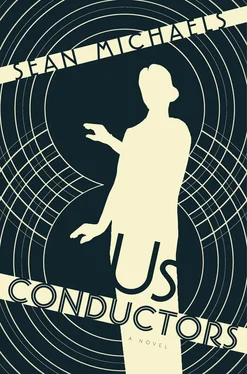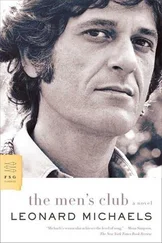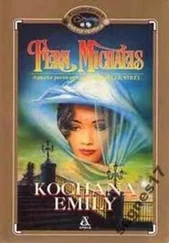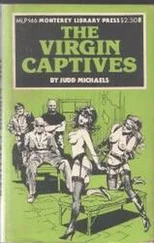Sasha was not prudent. He stood before my latest experiment with caked ice melting from the soles of his boots, the cuffs of his trousers. I was on the floor, patting the tiles dry. Water was a dangerous thing in the laboratories of the Physico-Technical Institute.
“It’s very clever,” Sasha said.
“Thank you.”
He tapped one of the dials with his fingernail. “This is the density?”
“Y — yes. Be careful. It’s very sensitive.”
Both of us had been at the Physico-Technical Institute for a couple of years. Sasha, the brilliant theorist, was already a senior researcher. I was less feted, coasting in on the fumes of my radio watchman. We worked together and apart: competitors, co-workers, scientists who sometimes went to concerts, or for cherry cake at Café du Nord, who talked of family and politics, of elementary particles. If I had mentioned my sister to him, it was to say that Helena seemed distant to me, a creature of another phylum. And if he had mentioned his own sister, Katia, it was not to reveal that she was pretty, or that she was unrelenting, like a flood; it was to describe a holiday they had shared as children, or the ham she had carved at New Year, while Sasha scored chestnuts.
I would learn for myself that blue-eyed Katia was pretty, that she was unrelenting.
I got up from the floor. Sasha was still peering at the same dial. “Very clever,” he repeated.
I hoped he would say something to Ioffe, my supervisor.
“But alas for the blind man,” Sasha said.
“What?”
“All these dials.”
There were many dials. Splayed before us, the device was a disparate contraption of coiled wires, readouts, rubber piping and a hissing chamber with two suspended plates. The plates formed a circuit: electricity jumped from one to the other, through the air. When the chamber was filled with gas, the electricity’s crackle changed, quickening or slowing. And thus it was able to measure the properties of various gases, particularly their dielectric constants. A dial read: 1.055.
“It’s a calamity,” Sasha said. “How will the blind man learn the dielectric constant of helium?”
“How is he to check his pocket watch?” I said.
“You mean he should ask his wife. Machines like this are the reason we don’t see more blind physicists.” The joke really entertained him. “Couldn’t you rig something up? Make it spray a new scent for each gas?”
“So sulphur gas can smell of roses?”
He chuckled.
“It would be easier for it to make a sound,” I said.
“If the constant’s higher than 1.2—a puff of cinnamon and the sound of a barking dog.”
“A tone,” I said. “Actually …” I thought about this. “A pitch that reflects the conductivity?” I picked up my notebook. “By adjusting the temperature, the gas could be made to sing a song. Or just wave your hand …”
Sasha tapped his fingertips against the wall of the chamber, making the dials’ needles wag. This made him laugh again. “But what about the frostbitten soldiers,” he asked, “without any fingers?”
I was no longer paying attention. I watched the needles flicker, a tiny back-and-forth, as if they were gesturing for my attention, and an image came to me, strongly, the kind of intuition a scientist leans on. It was like a film loop, the same scene over and over: a man inside a bell jar, his hand hovering above a metal plate, and the metal plate singing. La , it sang. Fa so la .
I looked at my own small hand.

THE THEREMIN WAS MORE OR LESS a combination of its precedents: the soundless watchman, the hissing gas monitor. I was measuring human movements as if they were the fluctuations of a gas, and adding sound.
The early prototypes were variations of the metal plates I’d shown Sasha, with added oscillators and an earpiece. I demonstrated the concept to the department head, Abram Fedorovich Ioffe. My waggling hand sounded out something between a shrieking bumblebee and Massenet’s “Élégie.” Ioffe was tickled. “One day,” he pronounced, “our orchestras will run on batteries.”
In November 1921, I was invited to demonstrate the theremin before the institute’s mechanical engineers and physicists, my first formal audience. I felt again like Lyova with a crate full of vacuum tubes. But these were not credulous dedushki and babushki ; these men had invented and reinvented radio, sent complex messages through the air. They spoke the language of electricity. They’d not be dazzled by twinkling little lights.
I was nervous. All right — I was petrified. Beforehand, I shut myself in Ioffe’s office. The sun had dipped behind the hills and filled the room with blue silhouettes. As I paced, the shadows skewed and reoriented themselves. I felt as though I was sabotaging something: the order in the room, its tranquillity, its dusk. I went to turn on the electric lamp on Ioffe’s desk, but it was broken. I took a small screwdriver from my jacket pocket. I was partway through the repair when he knocked on the door and said through the wood, “It’s time.”
In the low-ceilinged hall I stood beside the apparatus. Twists of smoke rose from cigarettes. I named and indicated the transformer, the oscillator, the unlit vacuum tubes. I closed the cabinet, concealing the components. I cleared my throat. “And so,” I said, and I turned the theremin on.
Here is the way you play a theremin:
You turn it on. Then you wait.
You wait for several reasons. You wait to give the tubes the chance to warm, like creatures taking their first breaths. You wait in order to heighten the audience’s suspense. And, finally, you wait to magnify your own anticipation. It is a thrill and a terror. You stand before a cabinet and two antennas and immediately the space itself is activated, the room is charged, the atmosphere is alive. What was potential is potent. You imagine sparks, embers, tiny lightning flecks balanced in the vacant air.
You raise your hands.
Raise the right hand first, toward the pitch antenna, and you will hear it: DZEEEEOOOoo , a shocked electric coo, steadying into a long hymn. Raise the left hand, toward the volume antenna, and you will quiet it.
Move your hands again, and the device will sing.
My theremin is a musical instrument, an instrument of the air. Its two antennas rise up from a closed wooden box. The pitch antenna is tall and black, noble. The closer your right hand gets, the higher the theremin’s tone. The second antenna controls volume. It is bent, looped, gold and horizontal. The closer you bring your left hand, the softer the instrument’s song. The farther away, the louder it becomes. But always you are standing with your hands in the air, like a conductor. That is the secret of the theremin, after all: your body is a conductor.
My colleagues at the institute did not applaud that day. They simply listened very carefully . I played works by Minkus and Massenet. I performed Saint-Saëns’s “The Swan.” I remember looking out over the sheet music into rows of faces, mostly moustached, and seeing Andrey Andreyevich Korovin, a man I had never spoken to, a man I had only seen, his features like the scored bark of a tree. Andrey Andreyevich had worked in the metals lab for fifty years. He had sharp grey eyes and a thin mouth. He was listening to me. My hand was in the air and I was playing a low note. Andrey Andreyevich Korovin, a man I had never spoken to, appeared to be on the verge of tears.
The theremin has always been a machine with two strangenesses. There is the strangeness of the playing: palms flexing in empty space, as if you are pulling the strings of an invisible marionette. But the stranger strangeness is the sound. It is acute. It is at once unmodulated and modulating. It feels both still and frantic. For all my tweakings of timbre, the theremin cannot quite mimic the trumpet’s joyous blast, the cello’s steadying stroke. It is something Else.
Читать дальше













